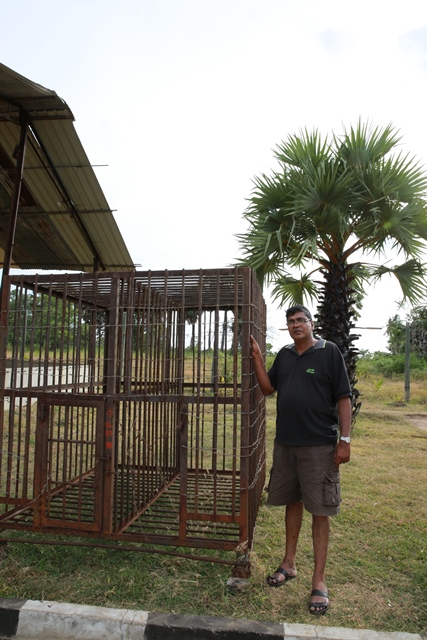( An alleged LTTE prison)
During the war in the North, the LTTE had the habit of attacking the army and police, capturing them, taking them away and imprisoning them. Thousands of soldiers and policemen suffered under the LTTE. In the line of duty army and police personnel sacrificed their lives to protect the country. Only a very few escaped from the clutches of the LTTE and returned to the South. We have published stories of such people in Ceylon Today. However, this is a story that we have not revealed even then. This is the story of an LTTE torture chamber especially meant for Tamils.
Inspector of Police Shanthalal who is at present the Officer-in-Charge of the Environment Section of the Kegalle Police, is someone who suffered immensely in LTTE prison camps. We published in parts, his story as well. However, this is a completely different story all together.
Although we were aware of the fact that LTTE terrorists who were claiming that they were fighting for the rights of Tamils, we did not know that they had treated people of their own race in a most inhuman manner. This is the story Shanthalal related to Ceylon Today.
“The LTTE did not have any special treatment for Tamil people. They tortured them in an abominable manner. We have seen such torture with our own eyes,” he said.
“This place I am talking about was in Thunukkai.”
“It was on the road from Mankulam to Mullaitivu. it was Mallavi that was known as Thanukkai.”
“Now, these areas have been completely liberated for people to live freely. However, this was a terrorist-infested area. Palmyrah trees that grew abundantly provided a dark shade to the area. Under the shade armed terrorists were roaming freely looking for their prey.”

“These camps had been built on a large area in the midst of the Thunukkai jungle where the forest had been cleared.”
Vietnam camp
At a glance it appeared similar to a Vietnam camp which was built during the war with America.The surrounding area is completely a desert. There was a huge barbed wire fence that had been put up encircling the camps. It is possible that it would have been over 15 feet in height. There were several barbed wire fences with more than 50 strands of wire in each fence. What was within the enclosure was a single building similar to a paddy storage warehouse. Beyond the barbed wire fence there were several other buildings. In every other place, there were guardhouses even on trees. No one could either enter or leave the place without getting caught. During the height of LTTE activities, it was a high security zone.
Beyond the fence the area there were many landmines. The security was so tight that even cat could not escape from the camp. Even if you get through the area, it was impossible for anyone to escape from the LTTE guards who used to inspect the surroundings with binoculars, Shanthalal said.
This was the internal structure of the place. However, LTTE did not use it as a war camp. It remained as a torture chamber.
“This was controlled by Kapil Amman who was one of the most handsomest members in the LTTE. However, amazing things took place under his purview.”
Sinhalese prisoners
“There were about 20 to 30 Sinhalese prisoners in the camp. Altogether there were about 1,500 inmates.
Apart from the few Sinhalese, the rest were Tamils. LTTE cadres tortured Tamil people more than the Sinhalese.”
“Similar to what happened during the World War II, they brought in Tamil families during the night.”
“Lorries had been allocated especially to transport the prisoners. There were also vehicles with metal sheet enclosures similar to the trucks the Postal Department used. About 100 people were brought in everyday. They removed their clothes and assaulted them. They questioned them while assaulting them mercilessly. Everyday we heard people screaming. Thereafter all the prisoners were chained. The chains were welded to the feet of the people. Then they questioned them again.”
Pits
“We too were in a pit in this camp. Pits had been dug everywhere. It was in these pits that these people were taken and dumped. It was the same for us too. We too were dumped in a pit.”
“Unlike us, the Tamil people were put into pits in a different manner. None of them had any clothes on. When they were brought initially, the stronger ones were separated and put into different pits.”
The pits were similar to graves. They were of the same length and breadth. A piece of wire was stretched across the top of the pits. All of them had electricity. The prisoners could not stand or sit in them. One had to lie down in the pit. If anyone stood up, they would shoot and kill them. They covered up the ‘graves’ with the dead bodies inside them.”
“Those who were brought in belonged to other Tamil organizations such as the People’s Liberation Organization of Tamil Eelam (PLOTE), Tamil Eelam Liberation Organization (TELO) and other Tamil organizations.
By Jeewana Pahan Thilina
